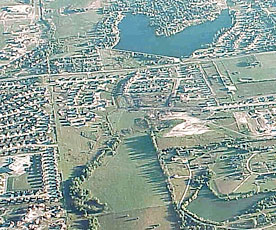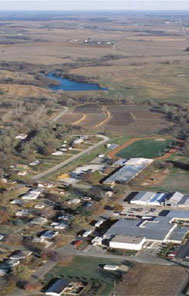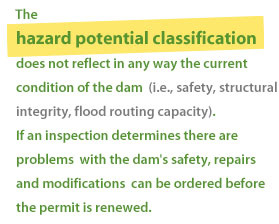About EAPs
What is a High-Hazard Potential Dam?
Each state has definitions and methods to determine the Hazard Potential of a dam. The Hazard Potential is defined as a situation which creates the potential for consequences such as loss of life, property damage, or other adverse impacts.
 Neighborhood association dams in suburban communities can be a significant risk to downstream residents and their homes, workers and their businesses, and even those who may be merely passing through the area.
Neighborhood association dams in suburban communities can be a significant risk to downstream residents and their homes, workers and their businesses, and even those who may be merely passing through the area.

Extensive development downstream from dams in rural areas will increase the risk to lives and property in the event of a dam failure.
These adverse impacts may occur in a defined area downstream of a dam because of flood-waters released through spillways and outlet works of the dam or because of waters released by partial or complete failure of the dam. Adverse impacts also may occur upstream of the dam from effects of backwater flooding or landslides around the reservoir perimeter.
In North Carolina, dams are regulated by the state if they are 25 feet or more in height and impound 50 acre-feet or more. Dams and impoundments smaller than that may fall under state regulation if it is determined that failure of the dam could result in loss of human life or significant damage to property below the dam. The height of a dam is from the highest point on the crest of the dam to the lowest point on the downstream toe, and the storage capacity is the volume impounded at the elevation of the highest point on the crest of the dam. (See this website's glossary for further terms and definitions.)
Dam Safety Program engineers determine the "hazard potential" of a dam, meaning the probable damage that would occur if the structure failed, in terms of loss of human life and economic loss or environmental damage. Dams are assigned one of three classes based on the nature of their hazard potential:
- Class A (Low Hazard) includes dams located where failure may damage uninhabited low value non-residential buildings, agricultural land, or low volume roads.
- Class B (Intermediate Hazard) includes dams located where failure may damage highways or secondary railroads, cause interruption of use or service of public utilities, cause minor damage to isolated homes, or cause minor damage to commercial and industrial buildings. Damage to these structures will be considered minor only when they are located in backwater areas not subjected to the direct path of the breach flood wave; and they will experience no more than 1.5 feet of flood rise due to breaching above the lowest ground elevation adjacent to the outside foundation walls or no more than 1.5 feet of flood rise due to breaching above the lowest floor elevation of the structure.
- Class C (High Hazard) includes dams located where failure will likely cause loss of life or serious damage to homes, industrial and commercial buildings, important public utilities, primary highways, or major railroads.
 The classification of dams can be changed if the hazard potential has changed. Flood plain zoning and early warning systems may be considered in making this determination. When dams are spaced so that the failure of an upper dam would likely cause failure of a lower dam ("cascading"), the consequence of the lower dam's failure determines the upper dam's hazard classification. In situations where a bridge or roadway is the only damageable property below a dam, hazard classification may be based on the possibility of loss of human life, indirect economic impact through loss of service, and direct cost of damage to the bridge or roadway.
The classification of dams can be changed if the hazard potential has changed. Flood plain zoning and early warning systems may be considered in making this determination. When dams are spaced so that the failure of an upper dam would likely cause failure of a lower dam ("cascading"), the consequence of the lower dam's failure determines the upper dam's hazard classification. In situations where a bridge or roadway is the only damageable property below a dam, hazard classification may be based on the possibility of loss of human life, indirect economic impact through loss of service, and direct cost of damage to the bridge or roadway.
| Hazard Classification | Description | Quantitative Guidelines |
|---|---|---|
| Low | Interruption of road service, low volume roads | Less than 25 vehicles per day |
| Economic damage | Less than $30,000 | |
| Intermediate | Damage to highways, Interruption of service | 25 to less than 250 vehicles per day |
| Economic damage | $30,000 to less than $200,000 | |
| High | Loss of human life* | Probable loss of 1 or more human lives |
| Economic damage | More than $200,000 | |
| *Probable loss of human life due to breached roadway
or bridge on or below the dam. |
250 or more vehicles per day |
The cost of dam repair and loss of services is included when calculating the economic loss estimate if the dam is a publicly owned utility, such as a municipal water supply dam.
The North Carolina Dam Safety Program provides a form that can be completed and submitted to determine the hazard classification of a dam.
Inspections, Exemptions, Laws and Regulations
All state-regulated Class C High-Hazard Potential dams are inspected at least once every two years. All class A and B dams are inspected at least once every five years. At any time an inspection indicates that a dam may not perform satisfactorily or that the hazard classification has changed, a detailed investigation can be ordered at the owner's expense to determine any required remedial action.
Not all dams 15 feet or more in height fall under state regulation in North Carolina. Dams constructed, licensed and maintained by the Tennessee Valley Authority or by U.S. government agencies are usually exempt from state regulation unless the agency has relinquished operation and maintenance of the dam to a local entity. Also exempt are dams constructed with financial assistance from the U.S. Department of Agriculture's Natural Resources Conservation Service (NRCS) if that agency designed or approved plans for the dam and supervised its construction.
The fact that a dam does not fall within the inspection jurisdiction of the Dam Safety Program does not mean it is safe. State dam safety regulators note that many of North Carolina's unregulated, private dams have gone unchecked for decades. Dams that don't get regular inspections can erode over the years, or be damaged by floods. Some of these potentially hazardous dams are several miles from a downstream city that would be threatened by a failure.
State dam regulations are found in North Carolina General Statute 143-215.23-37 and its amendments over the years since 1967.
Responsibility for state regulation of dams is by the North Carolina Dam Safety Program within the Division of Land Resources of the Department of Environment and Natural Resources. The Dam Safety Program provides a form that can be completed and submitted to determine whether a dam should be under state regulation.
The state's dam safety rules and regulations to administer the law are found in North Carolina Administrative Code - Title 15A Department of Environment and Natural Resources of Subchapter 2K - Dam Safety.
